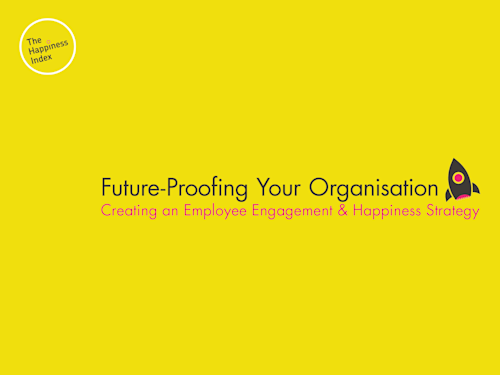
Creating an Employee Engagement AND Happiness Strategy
It’s increasingly clear that there are two types of leaders. There are those who are stuck in an outdated command and control mentality. And then there are those forward thinking business leaders who lead by example in an empathetic, human way. It’s clear that those stuck in the past are going to fall behind. Treating your people well is the future. Read on to find out how you can increase empathy in your leaders.
In this new working environment where employees are increasingly expecting to be listened to and understood, it’s vital that leaders across your organisation are able to be empathetic.
And it’s not just because it’s what people want. Neuroscience shows us that being understood and giving feedback is an key driver of happiness in the workforce. Since happiness drives performance, there’s a financial imperative to get this right.
Empathy is the ability to “place yourself in another person’s shoes” – so you can understand their perspective, thought-process and even their reality.
Empathetic leaders are able to relate to others within their organisation on a human level and strive to think about the impact of their decisions on a wider basis. Empathetic leaders often have a more personal relationship with those within their organisation at different levels, not only with others in senior positions.
This might seem like it’s easier within smaller organisations. While this is certainly true, there are still ways to build wider relationships and empathy within larger organisations.
For too long emotions have been excluded from the workforce. But emotions are part of the human experience, and empathy for other people’s emotional reality is important for understanding your team. More than just a buzzword, empathy is a vital component of successful leadership, and ultimately a healthy bottom line.
Empathy is a key skill for any leader looking to get the best out of their people. To be an empathetic leader, you should think beyond yourself and always consider the needs and desires of your people. After all, they are your most valuable asset.
But does empathy affect performance?
To better understand how leaders can be effective in their jobs, The Center for Creative Leadership conducted a study to address whether empathy is a necessary skill for effective leadership. Their results highlight that it is: “Empathy is positively related to job performance. Managers who show more empathy toward direct reports are viewed as better performers in their job by their bosses.”
The study clearly suggests that empathy is a vital leadership trait, which in turn will benefit the organisation and all its people.
Neuroscience shows us that empathy is important in almost every one of the 8 key neuroscience themes that build happiness and engagement. We can see that within the areas of trust, personal relationships, authenticity and recognition, empathy and understanding is vital to support a person’s happiness in the workplace.
When it comes to engagement, information flow is greatly increased by true empathy. Furthermore, people are more likely to feel inspired and committed when they believe their leaders are committed to them and their needs. Similarly true collaboration, especially between leaders and their teams requires empathy.
Building empathy within your organisation should be done at all levels of management, from those with small teams to senior leaders. Creating a culture of empathy will go a long way towards nurturing an environment where everyone can survive and thrive.
Anyone with any leadership responsibilities can benefit from empathetic leadership techniques.
There are 7 steps to cementing empathy as a core value within your organisation and particularly within your leadership teams:
To truly understand your people and be empathetic towards them you’re going to need to be listening to what they want and need. We always recommend that leadership have a personal relationship with as many people in their team as possible, but as your organisation grows this isn’t going to be enough.
Creating a listening strategy that helps everyone in your team feel listened to is going to be key to helping people understand and feel that your team values empathy. Investing in an employee engagement platform will literally put your money where your mouth is. Not only this but it will make listening to large groups of people more effective, and you will be able to analyse trends and take action.
Building listening as a practice from a top-down approach will also encourage leaders at all levels of your organisation to prioritise listening and empathy.
Everyone within your organisation is a unique individual, which means they will have unique needs. Understanding the diversity within your team will help you to create policies and processes that are empathetic to all your people and support them in their diversity.
It is hard to create a culture of empathetic leadership if, as a leadership team, you don’t know what the unique situations and needs of your people are. This is why data gathering exercises can build empathy on a larger scale. Not only this, but it will also help your people feel listened to, and when done right, increase feelings of acceptance within your organisation.
Sharing the results with your organisation can also support the wider team in having empathy for their colleagues.
Empathy doesn’t feel like true understanding if people perceive it as only skin deep. That’s why it is so important to back up your listening with action. By making changes off the back of what your people tell you'll demonstrate your empathy.
Setting aside time and resources for action planning is important, but you also need to gather actionable insight. This is where pre-built surveys which are designed by experts to maximise impact come in. Surveys like our Cultural Assessment give data on which to base many of your people strategy decisions, from specific needs like developing your CPD to generally informing your people planning.
To make empathy an ingrained part of your leadership culture you need to walk the walk, not just talk the talk.
The most authentic empathy involves a two-way conversation. You’re not just listening, you’re also showing people you understand. This is easy enough to do one on one, but harder at scale.
Our platform is designed to help you close the feedback loop. This means that you can reply to feedback within the platform while maintaining anonymity, showing people you’ve listened to and understood their concerns. This will really demonstrate empathy and help people understand they’re not just shouting into the void.
It’s also important when making empathetic leadership a culture within your organisation to present feedback you’ve received whether through a feedback platform like ours, or more informally through conversations. By sharing feedback at scale, and showing you’re taking action off the back of it, you’ll encourage more candid conversations and more empathetic touch points between your team.
One of the most important things about empathy is understanding everyone is an individual. This means that policies and programmes cannot be rolled out exactly the same to everyone.
When trying to instil a culture of empathetic leadership within your organisation, it really helps to empower managers. By letting them use their judgement when applying policies they will be able to show their empathy for their direct reports. This will free your managers and team leaders to support their people in the best way possible.
Flexibility should always be built into policies in order to accommodate everyone, but by giving latitude to your team to apply this to the individual circumstances that they face you’ll get better results and return on these benefits.
The truth is that sometimes a programme or policy seems like a good idea in theory, but doesn’t actually pan out in real life.
We’ve all made changes based on feedback and found that the implementation hasn’t worked out as well as we had hoped. You have received further feedback that leads you to develop or modify your original idea, or you may just run into roadblocks or other practicalities. When this happens it’s important to stay flexible and empathetic to the needs of everyone within your organisation.
Another unfortunate truth is that both the organisation’s needs but also those of the people on your team will change, and this might mean changing your approach. Building empathy within your leadership should also foster empathy within the rest of your team too, and so this flexibility should be two way.
The last step in the process is to be as open and honest with your people as possible. Honesty builds trust. The more your people trust you, the more they’ll be open with you too and build more opportunities for empathy.
As we mentioned before, true empathy should be a two way street, with each of you understanding where the other is coming from. By being open and vulnerable about what you are able to achieve as an organisation will help make empathy a cultural practice for everyone, not just leaders.
This is important because if you’re getting your retention and development strategies correct, you should be finding your next leaders from amongst your current high performers. Making empathy a habit for everyone in your organisation will kick start empathetic leadership down the line.

Linked to Happiness & Engagement in our neuroscience methodology... learn more
The Happiness Index helps organisations measure the key employee engagement AND happiness drivers to power their people strategy.
Our unique platform offers the products, insights and tools to shine a light on your cultural health and empower management to drive thriving cultures.
Our neuroscience-based pre-built surveys measure the full employee experience - from onboarding to exit to empower and enable organisations to understand their people and create data-led action plans.
